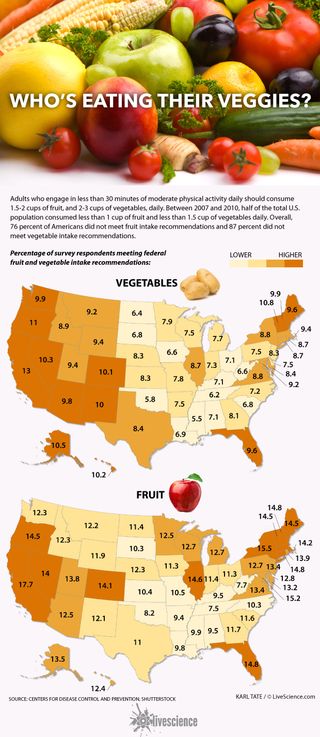Most Americans Still Don't Eat Their Fruits & Veggies

Didn't eat enough fruits and vegetables today? Join the club — 87 percent of Americans don't meet recommendations for fruit consumption, and 91 percent don't meet recommendations for vegetable consumption, according to a new U.S. report.
Researchers analyzed a 2013 survey of more than 373,000 American adults in all 50 states who answered questions about how much fruit and vegetables they eat. U.S. federal dietary guidelines recommend that people eat between 1.5 and 2 cups of fruit per day, and 2 to 3 cups of vegetables per day.
Overall, just 13 percent of people consumed enough fruit to meet the guidelines, and 9 percent ate enough vegetables, according to the report released today (July 9) from researchers at the Centers for Disease Control and Prevention. [Map: Fruit & Vegetable Intake in All 50 States]

When the researchers looked at fruit and vegetable consumption in each state, California did the best, but still only 18 percent of that state's residents ate enough fruit to meet the recommendation, and 13 percent ate enough vegetables, according to the report.
The worst state for fruit consumption was Tennessee, where just 7.5 percent of people ate enough fruit, and the worst state for vegetable consumption was Mississippi, where 5.5 percent consumed the recommended amount of vegetables, the researchers found.
"In 2013, most adults consumed too few fruits and vegetables," the researchers wrote in their report. "Because fruit and vegetable consumption affects multiple health outcomes and is currently low across all states, continued efforts are needed to increase demand and consumption."
To improve fruit and vegetable intake in adults, public health efforts might start with children, who also don't eat enough fruits and vegetables. "Better dietary practices earlier in life might lead to better practices later in life," the researchers said. Schools could help with this effort by meeting or exceeding federal nutrition standards for their meals, and making fruit and vegetables more appealing to kids.
Sign up for the Live Science daily newsletter now
Get the world’s most fascinating discoveries delivered straight to your inbox.
In addition, making fruits and vegetables available at work gatherings, such as meetings and conferences, might also improve intake.
"Increased attention to food environments in multiple settings, including child care, schools, communities and worksites, might help improve fruit and vegetable intake, and thus help prevent chronic disease," the researchers said.
The study will be published in the July 10 issue of the CDC journal Morbidity and Mortality Weekly Report.
Follow Rachael Rettner @RachaelRettner. Follow Live Science @livescience, Facebook & Google+. Original article on Live Science.

Rachael is a Live Science contributor, and was a former channel editor and senior writer for Live Science between 2010 and 2022. She has a master's degree in journalism from New York University's Science, Health and Environmental Reporting Program. She also holds a B.S. in molecular biology and an M.S. in biology from the University of California, San Diego. Her work has appeared in Scienceline, The Washington Post and Scientific American.











